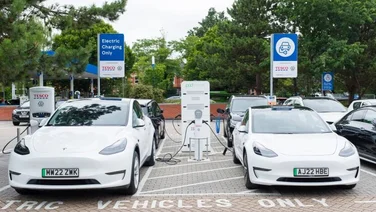- 83% of respondents ‘very satisfied’ or ‘satisfied’ with solar panels
- However, they still trail EVs
- Data demonstrates that widespread adoption of LCTs is possible

When it comes to investing in low-carbon technology (LCT), a clear majority of the UK public are happy and satisfied with their purchases, in particular solar panels, according to data from the National Home Energy Survey (NHES) 2024 – in association with Project Solar.
The NHES, which asked over 2,000 people for their opinion on 9 pieces of LCT – solar panels, heat pumps, solar batteries, wind turbines, electric vehicles (EVs) plug-in hybrid electric vehicles (PHEVs), electric vehicle charging points, electric boiler, and electric bikes/scooters – found 81% were either ‘satisfied’ or ‘very satisfied’ after purchasing them.
By contrast, the average percentage of people who said they were either ‘dissatisfied’ or ‘very dissatisfied’ was just 1.5%, with heat pumps scoring the worst on that front with 3%.
This should come as encouraging news, and it shows that when people are able to overcome the upfront costs and are made aware of the existing grants and initiatives designed to help, they are more than happy with the results.
That the UK public is generally extremely positive about LCT should be welcomed in Westminster as the government has made rolling them out to households central to its net-zero and sustainability plans.
Solar satisfies
That figure for satisfaction is even higher when it comes to solar panels, which 87% of people said they were either ‘satisfied’ or ‘very satisfied’ with, which demonstrates the potential for widespread adoption.
The high level of satisfaction with solar panels could be driven by the quick installation turnaround, which can sometimes be less than a day, and the potential energy savings.
Additionally, a three-bedroom house can start cutting bills by 50% from day one and can make their money back in just 15 years, 10 years before the end of a solar panel’s 25 year average lifespan.
It could also be down to their relatively low maintenance costs and the technology’s versatility, including bifacial solar panels, solar roof tiles and ones for irregularly-shaped roofs.
There are also initiatives such as the Smart Export Guarantee (SEG), which compels large energy suppliers to pay homeowners for renewable energy they send back to the National Grid.
Shirley Patterson, a homeowner in Fife, Scotland, who has owned solar panels since 2011, told The Eco Experts that they had helped cut her energy bills by about £66 a month and that she had made her money back in just five years.
However, while satisfaction for solar panels was very high, it was not the LCT with the best score. It was behind electric bikes/scooters on 93% and ranked the same as EVs on 93%.
The popularity of EVs may be due to the relatively lower running costs of EVs, along with the visibly more available charging infrastructure. It could be a similar story for electric bikes, which have plenty of charging infrastructure and also require low maintenance.
That EVs are so popular with the general public should calm fears expressed by the Energy Climate Intelligence Unit (ECIU) earlier in the year that consumers are put off by myths and misinformation.
Maximilian Schwerdtfeger, content manager, The Eco Experts, said:
“The huge amount of people satisfied with not only solar panels but LCT as a whole is really encouraging, and this should be taken as an endorsement of their potential to cut carbon emissions and energy bills.
“The government has rightly put a big emphasis on renewable energy. Hopefully they will make it easier to install solar panels and increase the number of people who say they’re ‘very satisfied’ with them.”
Tom Armstrong of Project Solar said it is “incredibly heartening” that the vast majority who invest in LCTs are satisfied, but pointed out that there remains a “clear gap between awareness and widespread adoption”.
“Over the last 13 years, we’ve consistently received the same positive feedback from our customers, who report significant savings on energy costs thanks to their solar panels,” Armstrong said.
“The challenge for government, industry leaders, and businesses alike is to bridge this gap—by effectively communicating the benefits, and simplifying the process for consumers to transition to cleaner energy.
“Together, we can meet the environmental and energy challenges of our time while empowering more people to embrace a greener way of living.”






